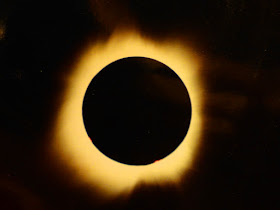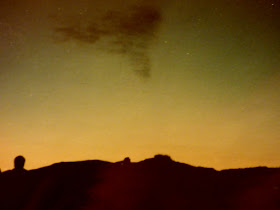 |
| The slough at the headquarters area of Dos Rios State Park |
Back in the 1980s, Douglas Adams published his hilarious "trilogy" of the
Hitchhiker's Guide to the Universe. The second book,
The Restaurant at the End of the Universe, was not about a restaurant at the edge of the Universe, but rather it was a place where you dined and watched the actual destruction of the Universe (you had to use a time machine to get there).
Today's blog is about the end of the Tuolumne River. But it isn't as bad as it sounds: it's about the spot where the Tuolumne River ends by flowing into the San Joaquin River. The confluence was on privately-owned ranch lands for many years, but a profound change is coming that will touch lives across our county and Central California. It is becoming California's newest State Park!
 |
| The confluence of the Tuolumne and San Joaquin Rivers |
Dos Rios State Park is the product of years of cooperation between the owners of the Dos Rios Ranch,
River Partners, and the
Tuolumne River Trust. In the last decade or so, the partners worked to return the former croplands to a landscape that functions like the original primeval environment that existed before the invasion of industrial agriculture. In other words, a riot of canopy trees like oak and cottonwood with a tangled undergrowth of willows, elderberries and numerous other native plants. This floodplain woodland acts as a giant sponge, absorbing and slowing down floodwaters and helping to recharge the groundwater underneath.
 |
| The lower Tuolumne River near the confluence. The state park is on the right-side shore |
The riparian environment provides a marvelous habitat for the wildlife that once thrived throughout the Great Valley of California (only about 5% of that original habitat remains). Dos Rios State Park will be a fantastic place to search for hundreds of bird species (more than 200 are known from just across the river at the San Joaquin River National Wildlife Refuge), and all manner of animal and plant species. The highly endangered Riparian Brush Rabbit is only found in an extremely small area within the San Joaquin Delta and the wildlife refuge across the river. I was told they intended to transplant a small group from the refuge to the park, but that the rabbits confounded the plan by crossing the river somehow and establishing a population all by themselves!

There are a number of ancient remnant environments tucked away in corners of the park. The most striking was a growth of valley oaks growing on a slightly elevated hill adjacent to the San Joaquin near the south end of the new park. There was a cacophony of bird songs in the canopy above, including Yellow-rumped Warblers, Oak Titmouse, White-crowned Sparrows, Tree Swallows, and Bush-tits.
The oak forest is a two mile walk from what will be the park headquarters area, and there are ideas of developing the site into an environmental walk-in campsite where local children can experience wilderness only a few miles outside their cities.
Much of the park will be a trailless, roadless morass of trees and brush on the floodplain. This is the area meant to serve for flooding relief, where it might remain underwater for weeks at a time. Volunteers have spent a decade planting native vegetation, and many of the trees are already tens of feet tall. They were irrigated for three years, but they will be able to survive on their own in the years to follow, watered by the higher groundwater table and occasional floods.
 |
| A "bunny hill" on the right side, a floodplain to the left. |
Several elevated areas across the park provide refuge for mammals during flooding events. I believe they called them "bunny hills". I've seen these in action during floods across the river at the wildlife refuge, where everywhere I turned, rabbits were waiting for the floodwaters to subside.
 |
| The tangled thicket of native vegetation: the valley floodplain as it once was. |
One of the most valuable aspects of the park is that it will allow visitors to experience the valley habitat as it once was, and how many parts can once again be. On our tour, we mentioned the wonderful resource of the Great Valley Museum at Modesto Junior College where I teach. Visiting the museum, children can view dioramas of the natural environments of the valley and even see a few live animals. But what if...they could learn about these environments, and then drive a short distance and actually experience them? That's the incredible value of the Dos Rios State Park.
 |
| Double-crested Cormorant in the slough |
When our tour ended, I spent a few moments wandering the only developed part of the park. There is a picnic area that has been constructed adjacent to the farm buildings serving as the park headquarters for the moment. There is a slough below the picnic structures with a short walkway providing panoramic views. It didn't take long to find some interesting birds, like the Double-crested Cormorant drying its wings on a stump.
I only occasionally see Downy Woodpeckers along the Tuolumne upstream, but it was the first one I sighted today. I also saw Northern Flickers and Nuttall's Woodpeckers.
A Great Egret was watching for fish on the far side of the slough.
Turtles were basking on logs down in the slough below.
Dos Rios State Park will open this coming summer with the picnic area and slough area open for visitation. A master plan will be developed over the next few years, with proposals for a campground, trails, and all manner of interpretive programs. Even better, the park will function as an environmental buffer, providing habitat and flood protection. The park is starting with about 2,100 acres, but other adjacent tracts are being "de-developed" to resemble their original habitat.
It was a real privilege having the opportunity to see this park and renewed floodplain in the making. I'm looking forward to seeing what lies ahead for this beautiful new park in coming years. It is a marvelous resource for our community.
 |
| Source: River Partners and the Tuolumne River Trust |























